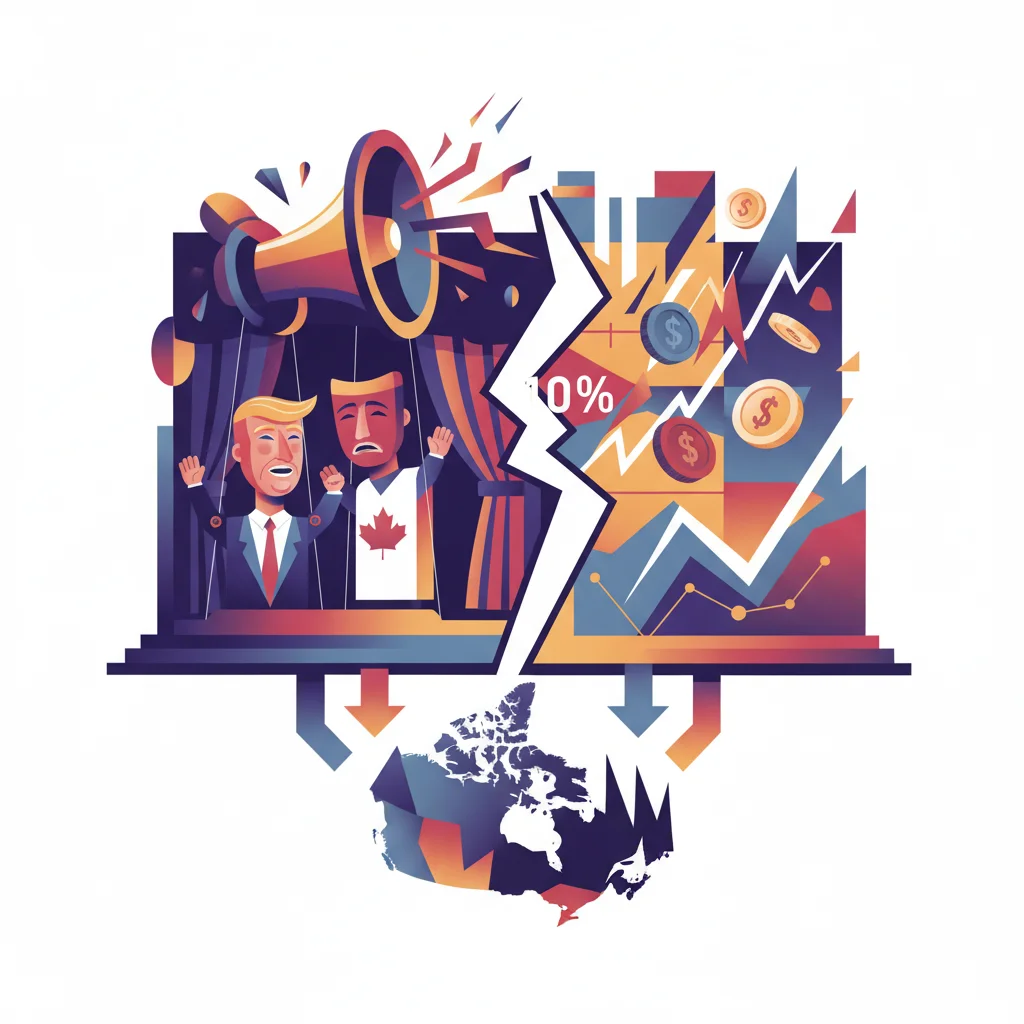
Political Theater, Economic Tremors: Decoding Trump’s New 10% Tariff on Canada
In a move that sent immediate ripples through the worlds of international politics and finance, former President Donald Trump announced a sudden and significant escalation in trade tensions with one of America’s closest allies. Citing a Canadian-aired political advertisement featuring Ronald Reagan as a “hostile act,” Trump declared his intention to impose an additional 10% tariff on top of existing levies on Canadian goods. This single announcement, as reported by the BBC, serves as a stark reminder that in today’s interconnected global economy, political rhetoric can become economic policy in the blink of an eye. For investors, business leaders, and finance professionals, understanding the multifaceted implications of this decision is not just academic—it’s essential for navigating the volatile landscape ahead.
The Catalyst: When an Advert Becomes a “Hostile Act”
The immediate trigger for this new trade salvo is, on its surface, unconventional. The advertisement in question reportedly used archival footage of President Ronald Reagan to champion principles of free trade, international cooperation, and a strong NATO alliance—themes often associated with a more traditional Republican foreign policy. While the exact content and its sponsor remain subject to analysis, sources suggest it was crafted to draw a sharp contrast between Reagan’s collaborative internationalism and Trump’s “America First” doctrine of economic nationalism.
Labeling a political advertisement a “hostile act” is a dramatic escalation of diplomatic language. Typically reserved for military aggression or espionage, its use in a trade context signals a willingness to blur the lines between political messaging and economic warfare. This move suggests that any perceived slight, whether from a government or a private entity within that nation, can be met with significant economic consequences. This unpredictable approach to foreign policy creates a new layer of risk for international businesses and investors, where a marketing campaign could inadvertently spark a multi-billion dollar trade dispute.
Dissecting the Economic Impact: A Closer Look at the New Levies
An additional 10% tariff is far from a trivial adjustment. It represents a direct tax on goods imported from Canada, a country that stands as one of the United States’ largest trading partners. In 2023, the total trade in goods and services between the two nations exceeded $900 billion, according to the U.S. Census Bureau. The new tariffs will be applied on top of any existing duties, including those from the 2018 steel and aluminum disputes, creating a compounding financial burden.
The impact will be felt across numerous sectors that rely on the deeply integrated North American supply chain. To understand the potential scale, let’s examine some key Canadian exports to the U.S. and the hypothetical effect of this new tariff.
| Product Category | Approx. 2023 Export Value to U.S. | Existing Tariff Rate (Example) | New Total Tariff Rate | Primary U.S. Industries Affected |
|---|---|---|---|---|
| Softwood Lumber | $13 Billion | ~8% | ~18% | Construction, Home Building, Real Estate |
| Aluminum | $12 Billion | 10% | 20% | Automotive, Aerospace, Beverage Cans |
| Automotive Parts | $45 Billion | 0% (under USMCA) | 10% | Automakers, Vehicle Manufacturing |
| Crude Oil | $100+ Billion | Varies | +10% | Energy Refineries, Transportation, Plastics |
Note: The table above is illustrative, based on publicly available trade data. The exact application of tariffs can be complex and subject to specific product classifications.
This tariff acts as a direct cost increase for American businesses that import these materials. A home builder in Arizona will pay more for Canadian lumber, an automaker in Michigan will face higher costs for aluminum and parts, and ultimately, these costs are often passed down to the American consumer in the form of higher prices. This has direct implications for inflation and the overall health of the U.S. economy.
Sailing into the Storm: Why the Offshore Wind Revolution is Facing a Financial Crisis
The Ripple Effect: From the Stock Market to Your Shopping Cart
The consequences of this tariff will not be contained at the border. They will ripple outward, touching nearly every corner of the North American finance and business landscape.
Volatility in the Stock Market
The stock market abhors uncertainty, and this action injects a significant dose of it. Companies heavily reliant on the U.S.-Canada supply chain will likely see their stock prices come under pressure. This includes automotive giants, railway and logistics companies, and major retailers. Investors will be forced to re-evaluate the risk profile of companies with significant cross-border operations. Sector-specific ETFs in materials, industrials, and energy may experience heightened trading volumes and price swings as the market digests the news.
A Test for North American Supply Chains
For decades, businesses have built highly efficient, “just-in-time” supply chains that treat the U.S.-Canada border as a minor checkpoint. This tariff throws a wrench into that finely tuned machine. Businesses will face a difficult choice: absorb the new costs and reduce profit margins, pass the costs to consumers and risk losing market share, or undertake the expensive and time-consuming process of reconfiguring their supply chains. This disruption underscores the fragility of globalized production and may accelerate a trend toward near-shoring or on-shoring, a topic of intense discussion in boardrooms worldwide.
The Specter of Retaliation
Trade wars are rarely a one-way street. The Canadian government is now under immense pressure to respond. Retaliatory tariffs are a near certainty, and they will likely be strategically targeted to inflict maximum political pain in the U.S. As the Peterson Institute for International Economics noted in its analysis of the 2018 disputes, retaliatory tariffs often target American agricultural exports like soybeans and bourbon, as well as manufactured goods from key political swing states. This tit-for-tat escalation can quickly spiral, harming businesses and consumers in both nations and creating a drag on the broader global economy.
Navigating the New Normal: The Role of Financial Technology
In an era of heightened geopolitical and economic volatility, technology becomes a critical tool for risk management. The financial technology, or fintech, sector is rapidly developing solutions to help businesses and investors navigate these turbulent waters.
Modern banking and treasury platforms now offer sophisticated currency hedging tools, allowing companies to lock in exchange rates and protect themselves from currency fluctuations that often accompany trade disputes. Advanced data analytics platforms can model supply chain vulnerabilities and help businesses identify alternative sourcing options before a crisis hits. For those involved in trading, AI-powered algorithms can scan global news and social media sentiment to provide early warnings of politically-driven market shocks.
Further afield, technologies like blockchain offer a long-term vision for more resilient trade. By creating a transparent, immutable ledger of transactions, blockchain has the potential to streamline cross-border payments, automate customs compliance, and provide end-to-end visibility into supply chains. While not a solution for politically motivated tariffs, it represents a technological push toward a more efficient and transparent global trade infrastructure, which could help mitigate some operational frictions in a fragmented world.
Conclusion: Politics as a Portfolio Risk
The decision to levy new tariffs on Canada over a political ad is a powerful illustration of the new era of geopolitical economics. It demonstrates that trade policy is no longer the exclusive domain of economists and negotiators but is now a frontline tool in the arsenal of political showmanship. The immediate fallout will be felt in the balance sheets of corporations and the wallets of consumers. The long-term consequences could include a fundamental rethinking of North American economic integration, a process that has been decades in the making.
For anyone involved in finance, investing, or business leadership, the message is clear: political risk is now market risk. Building resilient operations, diversifying supply chains, and leveraging financial technology to stay ahead of the curve are no longer best practices—they are survival imperatives in a world where a single headline can reshape the economic landscape.
The Absurdist's Edge: Why Acknowledging Workplace Nonsense is a Winning Investment Strategy


